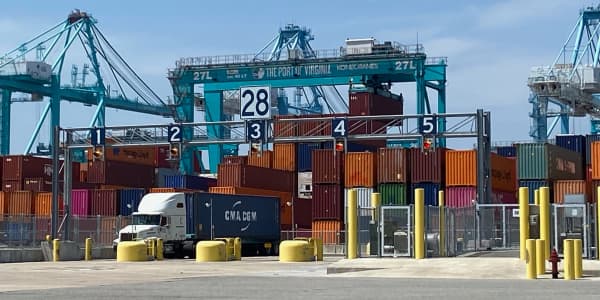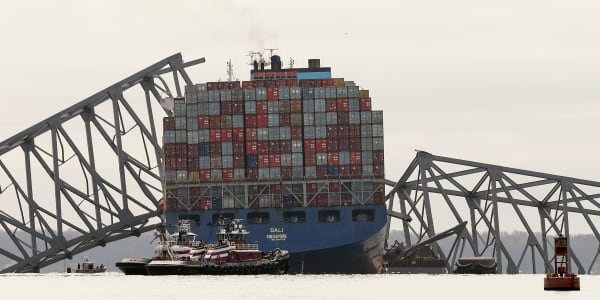ILWU union labor slowdowns on the West Coast continue to push up the wait times to pick up coveted containers. Even as ports remain open and port officials cite "close to normal" operations, vessels are still stuck at the docks of the ports of Los Angeles, Long Beach, and Oakland as a result of labor shortages.
In addition to six vessels previously reported as delayed across these three California ports, an additional five ships had been delayed, bringing it up to 11 on Tuesday evening, according to an email statement from Captain J. Kipling (Kip) Louttit, executive director of Marine Exchange of Southern California. "Per the agents [the] delays [are] due to labor shortages. We'll keep you advised as we get more," he wrote.
CNBC has since reviewed the status of the vessels listed, and two vessels were able to leave, one from the Port of Los Angeles and the other from the Port of Long Beach, bringing the number of vessels stuck at port to nine at press time.
Logistics intelligence firm Project44 says data shows the lack of port productivity impacting the movement of vessels in and out of dock.
"In addition to waiting times of containers still at the West Coast ports, we are starting to see an upward trend in the length of time vessels are at the dock as well," said Jessica Slagle, senior data analyst at marketing for Project44, referring to how long it takes for a vessel to be unloaded and loaded.
The White House is monitoring the labor situation at West Coast ports very closely, Biden press secretary Karine Jean-Pierre said at a media briefing on Tuesday. She said the White House continues to encourage all parties to work in good faith. Biden's Acting Labor Secretary Julie Su, whom CNBC reported earlier this week has engaged with both the union and port management to reach a resolution, was on the ground in California on Tuesday attempting to broker a deal.
The Department of Labor told CNBC on Wednesday that Su, who flew out to California on Monday night, remains engaged with both the union and port management in talks in San Francisco on Wednesday.
The National Retail Federation, the National Association of Manufacturers, and the U.S. Chamber of Commerce have all urged the Biden administration to intervene.
"Global supply chains cannot tolerate this level of uncertainty of operations at our West Coast ports," said Stephen Lamar, President and CEO of the American Apparel & Footwear Association. "Further disruptions will surely multiply the impacts of inflation and inventory imbalances. The PMA and ILWU have had more than a year to conclude these talks. It's now time for President Biden to step in to ensure that the parties quickly reach a fair, responsible, and sustainable deal. Enough is enough!!"
Supply chain fears are running high from trucking to rails and ocean carriers. Billions of dollars in cargo has been held up off ports, container congestion and delays have led to longer service and turnaround times. Further complicating the crisis planning for logistics firms was a landslide vote by ILWU Canada workers to authorize a strike at Canadian West Coast ports, and low water levels at the Panama Canal, which make the option of alternate trade routes on both the West Coast and the East Coast ports more difficult.
What's holding up a union labor deal
One of the major sticking points in the talks between the International Longshore & Warehouse Union and Pacific Maritime Association, which during the spring were reported to have made significant progress, is the subject of wages. Automation also has been cited as a difficult issue to resolve, with U.S. ports wanting to increase the use of automation — the level of robotics at U.S. ports is behind many overseas port operations.
"We aren't going to settle for an economic package that doesn't recognize the heroic efforts and personal sacrifices of the ILWU workforce that lifted the shipping industry to record profits," ILWU International President Willie Adams said in a recent statement amid the spike in labor issues.
According to the PMA 2022 report, full-time ILWU workers on average were paid $211,000. ILWU foremen who oversee the longshoremen earned a little over $300,000.
The entire West Coast has been impacted by the labor slowdowns, with the ILWU and PMA trading accusations about the causes. The PMA has cited "coordinated" actions by the union; the ILWU has said rank-and-file members are "voicing their displeasure."
CNBC has reported on union workers not showing up for shifts, which led to a recent port shutdown in Oakland; union workers pulled off daily shifts by port management for low productions levels; and port daily labor orders being unfilled, even ignored by unions.
At the Port of Seattle, which was closed at one point last weekend, container terminal SSA continues to let go of union workers daily for poor productivity.
At the Port of Los Angeles monthly briefing on cargo volumes on Tuesday, port executive director Gene Seroka fielded numerous questions on the slowdown and labor negotiations. Seroka characterized the last couple of weeks as "challenging."
"At the Port of Los Angles, I think it's fair to say that while the situation remains fluid, we've been able to largely function close to normal since June 1. The port is open, trucks are moving and vessels by and large are on schedule."

But the truckers, the men and women on the ground attempting to pick up and drop off containers, tell CNBC the present situation is far from normal.
"It is taking our truckers three hours to get in and out of the port," said Paul Brashier, vice president of drayage and intermodal at ITS Logistics. "The terminal congestion is not improving."
Key positions such as lashers, laborers that tie down the containers to ensure they stay safely on the vessel during transit, did not show up last week and over the weekend, which impacted vessels attempting to leave the port.
In response to questions from CNBC on Tuesday about these vessel delays and key labor positions not being filled, Seroka said, "There's a variety of issues every day. There are a variety of jobs and skills that are required every day across the 12 terminals here across Los Angeles and Long Beach. I can't point my finger at any one job class, one workgroup, or at any one employer that's doing things differently, but safe to say, we're not operating at full capacity today. That is why the focus needs to be on moving that container to the best of our ability and encouraging both sides to stay at the table, bargain in good faith and get to a tentative agreement."
The movement of import containers is moving faster than the processing of U.S. exports at the Port of Los Angeles.
For the Port of Long Beach, the processing of imports is ticking higher versus a drop in the movement of U.S. exports.
At the Port of Oakland, which was shut down for three days, the terminals have been able to cut the time to move out exports but the times for containers to be picked that are destined for store shelves is increasing.
This sluggish pace of trade is hanging over labor discussions being held in San Francisco between the ILWU and the PMA.
Seroka said he is keeping a close eye on dock operations and is optimistic about peak shipping season — the period between July and October when inventory for back-to-school and the holidays come in to port — but stressed labor negotiations need to be resolved as soon as possible.
West Coast ports have lost share of trade over the past year to East Coast ports due to concerns among shippers about the labor situation. Those fears had been receding in the spring amid the reports of progress in the talks and volume at West Coast ports was picking up again.
"A contract agreement is the first step in bringing back trade to the West Coast," Seroka said.





